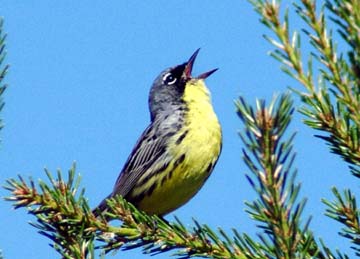This is the second in a series of weekly posts highlighting birds considered to be at risk in Canada. The Committee on the Status of Endangered Wildlife in Canada (COSEWIC) lists 73 bird species or subspecies, divided into three categories: Endangered, Threatened and Special Concern.
The fact that any of these birds exist today is something close to a miracle, and their struggle for survival must be unique in the bird world. There are indications, however, that it`s a story with a happy ending.

Kirtland's Warblers have the most limited breeding range of any North American bird
These small birds have bluish-gray backs with black streaks, yellow breasts, black side streaks and split white eye rings. They measure 14-15 cm (5.5–5.9”) in length. Females are not as brightly coloured as males.
Primarily insect eaters, Kirtland’s warblers forage for insects and larvae near the ground and in lower parts of pines and oaks. They also eat blueberries.
They arrive on their nesting grounds mostly in mid-May, and gradually depart during August and September, migrating to the Bahamas.
The COSEWIC Status Report states:
Kirtland’s Warbler formerly bred in Ontario and possibly Quebec. They continue to wander into Canada, with one or two sightings a year during the 1990s, and possibly other individuals have visited, but remained unseen. The goal of the U.S. recovery team is to have a self-sustaining population of at least 1000 pairs. If the population continues to grow, there is the possibility that a few pairs could begin seeking breeding opportunities in Canada again. There is habitat available in Ontario that could be used by this species, and it has demonstrated the potential, even now, of expanding to new areas.
These birds are true niche specialists. They nest only on the ground near the lower branches and in large stands of young jack pines that are 5 to 20 feet tall and 6 to 22 years old. The tree’s age is crucial, although biologists are not sure why. It is possible that the birds need low branches near the ground to help conceal their nests. Before the trees are six years old, the lower branches are not large enough to hide the nest. After 15 years, these lower branches begin to die.
Concealed by branches, overhanging grass and low shrubs, the warbler’s cup-shaped nest is made of grasses. While being fed by their mates, females incubate four to five eggs for about 14 days. After hatching, the chicks remain in the nest for another 9 or 10 days. One pair of nesting warblers requires at least 8 acres of dense young jack pine forest to nest, but often 30 to 40 acres is needed to raise the young.
Rigorous suppression of forest fires contributed to their decline. Without fire, jack pine cones do not completely release their seeds and new growth was inhibited. Since these warblers will only nest in stands of young jack pines, the population dwindled dramatically before scientists realized that fires have a role in forest ecology.
The second greatest threat to the Kirtland’s warbler is the Brown-headed Cowbird. Cowbirds lay eggs in other bird’s nests, leaving the unsuspecting hosts to incubate and care for the young.
When a female cowbird lays its egg in a nest, it often removes one of the host’s eggs. The cowbird egg hatches before the others, getting a head start on growth. The young cowbird is bigger and able to claim more food than other nestlings, and may crowd or push the other baby birds out of the nest. More than 70% of warbler nests were found to have been parasitized by cowbirds.
With a total population of only about 200 pairs of warblers left in 1971, intensive efforts were begun to control Brown-headed Cowbirds. The U.S. Fish and Wildlife Service, in cooperation with the Michigan Department of Natural Resources, the U.S. Forest Service and the Michigan Audubon Society, initiated an aggressive cowbird removal program in 1972 that has continued to this day.
About 190,000 acres of public lands have been set aside specifically for Kirtland’s warbler management. Thousands of acres of jack pine forest are cleared and replanted annually to establish a permanent breeding area for these birds.
Until 1995, they had only been known to nest in the northern part of Michigan’s Lower Peninsula. Today they also nest in the Upper Peninsula, and since 2007, have also nested in central Wisconsin, and on a military base in eastern Ontario.
Kirtland’s warbler conservation measures are working. From a low of 167 in 1974, the number of singing males increased to 1,803 in 2008. The species is getting more numerous every year, and has now well exceeded the original recovery target of 1,000 breeding pairs.



Pingback: JournOwl- Wildlife news, Wildlife conservation » Wildlife Bulletin Debut - week 1
Thanks for the comments. Sighting a Kirtland’s Warbler would be fantastic anywhere, but even more so in the Bahamas. Let me know how you do!
Having recently been offered a trip to the Bahamas in February my must see bird is the Kirtland’s Warbler!!! Nice to read more about it here!!